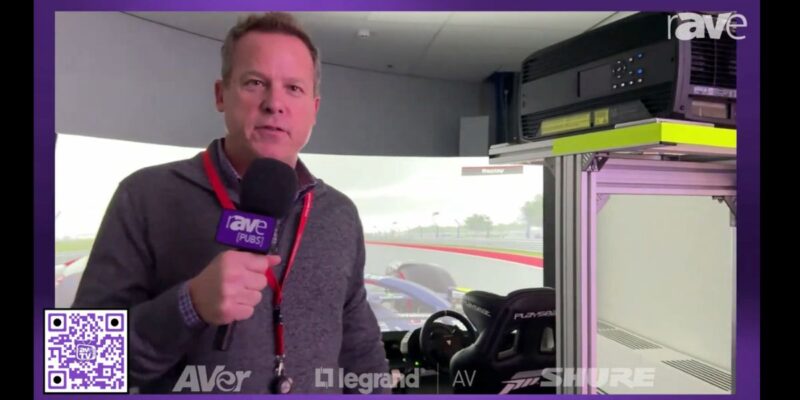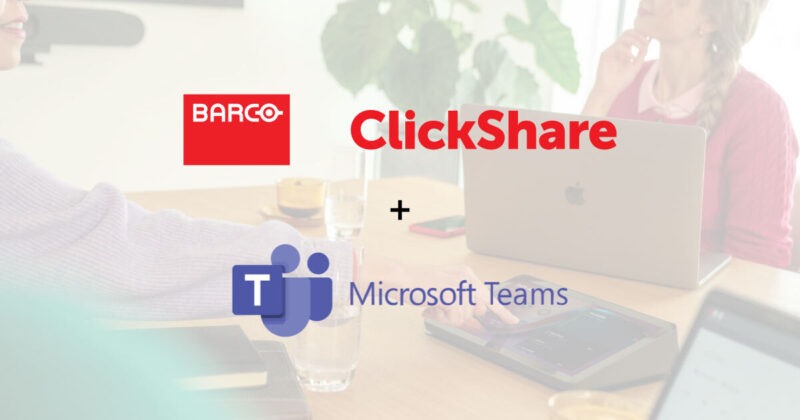Open Rooms, The Answer to Hybrid Meetings in Your Workplace
THIS IS A PROMOTED POST
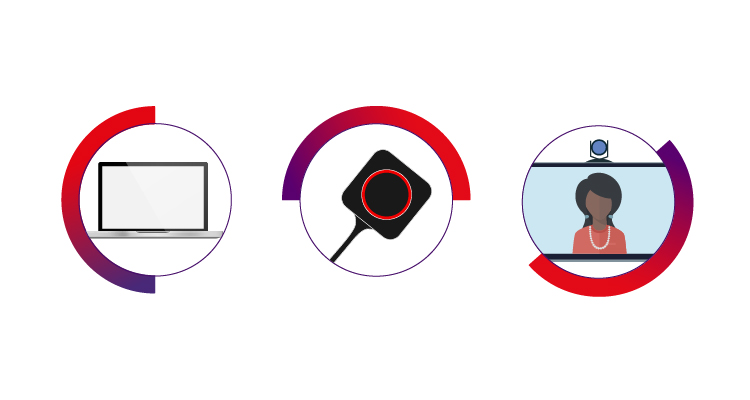
Times are changing, and today’s hybrid working world — with some people at home and some in the office — means team collaboration is more necessary than ever. We’ve got a great story to share with you today, and we hope you’ll read it in full, but let’s be realistic; you want the point as early as possible. So here it is: A new approach to hybrid working — enabled by wireless BYOM (that’s “bring your own meeting”) technology and a new concept from Barco called “Open Rooms” — is the path forward for AV and IT when designing UCC spaces for the future. And so this story begins.
What Happened in 2020?
Earlier this year, mere weeks before the COVID-19 pandemic moved into full swing, Barco revolutionized the meeting room once again with a familiar brand: ClickShare. You already know and love ClickShare, but Barco’s 2020 evolution of it took major new strides. This time around, it was a UCC (unified communications and collaboration) specific product that Barco dubbed ClickShare Conference. Distinguished as its own product family, ClickShare Conference built upon what was already considered to be one of the best collaboration solutions of the decade — ClickShare — to enable insanely easy one-touch meetings in collaboration spaces of all shapes and sizes.
The launch of ClickShare Conference in February 2020 kicked off what would have been the UCC enabler of the year had the global pandemic not come in and shaken up the AV industry like it did. By September, sans COVID-19, we would have predicted nearly 40% of all new meeting room installs to transition from a room-based meeting (RBM) or room-based system (RBS) — aka the Microsoft Teams Room, Zoom Rooms, etc. — to BYOM, or bring your own meeting.
Perhaps you’ve already seen and heard of BYOM; you should have by now, it’s pretty much everywhere. Barco’s take on BYOM, however — wireless BYOM — gives power to the people and is differentiated from other BYOM solutions. How? Notice the “wireless” before “BYOM.” That extra word makes a big, big difference. (We’ll explain why soon.)
Onto the next chapter: how the wireless BYOM concept of ClickShare Conference emerged.
Zoom, Teams or Webex? With ClickShare Conference, You Can Have All Three (And More)
 Through wireless BYOM, Barco sought to bring together the top UCC platforms (e.g., Zoom, Microsoft Teams, Cisco Webex, etc.) and create one great user experience in the meeting room, ensuring each platform could work with the other in a ClickShare Conference–enabled space. Before ClickShare Conference, you could say these platforms, well, didn’t exactly get along … in room-based systems, at least.
Through wireless BYOM, Barco sought to bring together the top UCC platforms (e.g., Zoom, Microsoft Teams, Cisco Webex, etc.) and create one great user experience in the meeting room, ensuring each platform could work with the other in a ClickShare Conference–enabled space. Before ClickShare Conference, you could say these platforms, well, didn’t exactly get along … in room-based systems, at least.
Take Zoom: manufacturer of the most popular videoconferencing platform in 2020, thanks to its move near the start of the pandemic to offer free individual licenses to mainstream users, like teachers. Long before COVID-19, though, AV and IT were building meeting rooms designed specifically around their organizations’ preferred UCC platforms, like Zoom. Why? So that employees could more easily connect to their video meetings using the room’s professional AV equipment (e.g., the large front-of-room display) — something that has, traditionally, been quite complicated for users to manage. The Zoom Room, designed by Zoom but specified for enterprise spaces by the actual AV/IT departments, made joining in-room meetings simpler. Zoom Rooms are an example of the RBM or RBS we introduced earlier.
Now, everyone loves a platform-dedicated room — as long as they have that platform. Herein lies the problem: A Zoom Room, for example, is great if it’s being used exclusively for Zoom meetings. But once you need that room (and its subsequent AV equipment) to connect to, say, a Teams call, a BlueJeans call or a Webex meeting, panic ensues. Additionally, if users want to use the professional camera, display or speakers in that room for a meeting held on another platform (one that’s different from what the room was built for), you can go ahead and cue the frustration.
“How do I get out of Teams to access a meeting on Webex? How do I work this touch panel again? How do I put the meeting on the big screen in the room?” These are just a few questions AV and IT will get on the regular if they choose to specify room-based systems. And if it’s even just a little bit complicated for users, you can count on a delayed start to the meeting. In fact, it typically takes 12% of a meeting’s duration just to set up the equipment (seven minutes for every one-hour meeting).
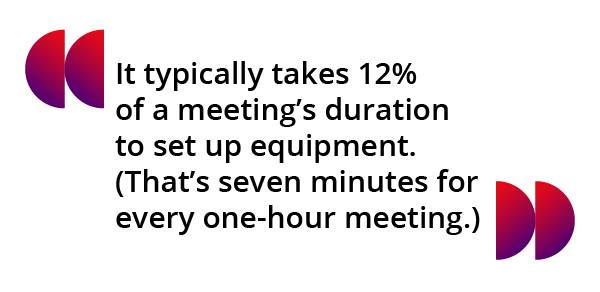
Source: Barco whitepaper: “BYOM The next step towards the digital workplace”
You see, room-based systems are purpose-built — and as long as that’s the purpose of that room, it’s all good and well. But as soon as that RBS needs to accommodate another meeting platform, or even just be used to show a PowerPoint presentation, you need to train all room users on how to make that happen. That means facility-wide training, short of having a dedicated AV or IT tech available all the time.
Or you can consider Barco’s alternative. Enter wireless BYOM.
What’s the Point of Wireless BYOM?
BYOM, or the concept of bringing your own meeting, is unusually simple.
First consider how people meet virtually both inside and outside their companies: 27% of organizations have tried to mandate the use of a single conferencing or UC platform by their people. They’ve not been successful, because the reality is not every company uses the same UC platform! According to statistics from UCC professionals, in fact, people use an average of six different conferencing solutions for business over a six-month span. Six different platforms! That includes meetings that go from Webex to Teams, Teams to BlueJeans, BlueJeans to Zoom, Zoom to Google Meet, Google Meet to Webex — you get the picture.
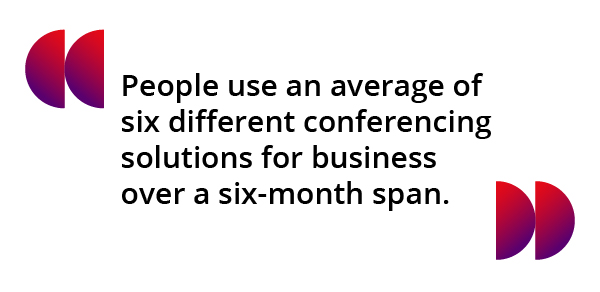
Source: Barco whitepaper: “BYOM The next step towards the digital workplace”
Now to explain the “bring your own” part of the BYOM acronym: Most corporate workers nowadays primarily operate with their own laptop, tablet or even smartphone. Because these devices are “ours,” we know how to use them, manage them and even do presentations from them. They’re our devices — we know the quirks; we know the device settings.
Imagine we’re in our meeting room. There is likely no other device we feel as comfortable with than our own. So why not use our own devices to launch any meeting inside of any room? With ClickShare Conference, using your own device, that’s what happens — you just click on the meeting link, no matter the platform it’s hosted on, and voilà. The appropriate UCC application has been launched and your meeting appears on the front-of-room display. We’ve automatically connected to the speakers and camera, too, and no setting adjustments are needed (i.e., no messing with audio or video levels). No need for an AV or IT technician.
That’s BYOM.
Before BYOM, the complexity of launching, for example, a Webex meeting in a Teams Room was unfathomable. Sure, an AV or an IT professional could do it or teach the tech-savvy workers how to do it. But what about the deep thinker, and not necessarily the tech-loving, media buyer at an advertising agency who just needs to meet for 10 minutes with a research firm to confirm data collection? What about the print producer who just wants to present some samples to a client buying 10,000 silk-screened T-shirts? If they walk into an RBS and realize their client call is hosted on another platform, do you think they’re going to know how to easily convert their room for the meeting?
In essence, ClickShare Conference does all the hard work for you — connecting to room peripherals — camera, speaker, mic — instantly. All users have to do is click on the meeting link. The significance? People aren’t stuck using the sole platform their conference room was set up for. And integrators can actually enable clients to use that expensive room hardware they paid for. Wireless BYOM enables people to connect to conferences directly from their laptops (rather than using the room-specific equipment, like the touch panel). This benefit aligns with recent data that, evident from Barco research, 60% workers returning to the office post-COVID-19 want to host videoconferences from their own laptops, instead of using the room-based systems.
BYOM Evolves: Why “Open Rooms” Are Brilliant
While ClickShare Conference is a revolutionary wireless BYOM solution, the bring-your-own-meeting approach is not exclusive to Barco, as we previously mentioned. BYOM is now a market position of many professional AV manufacturers, like Logitech (product: Swytch), WolfVision (product: Cynap), T1V (product: HubVC), Biamp (product: Huddle Hub One) and Mersive (product: Solstice Conference) — just to name a few and state the obvious that competition exists. Even interactive touch displays like those from SMART Technologies embody the BYOM revolution within the product design.
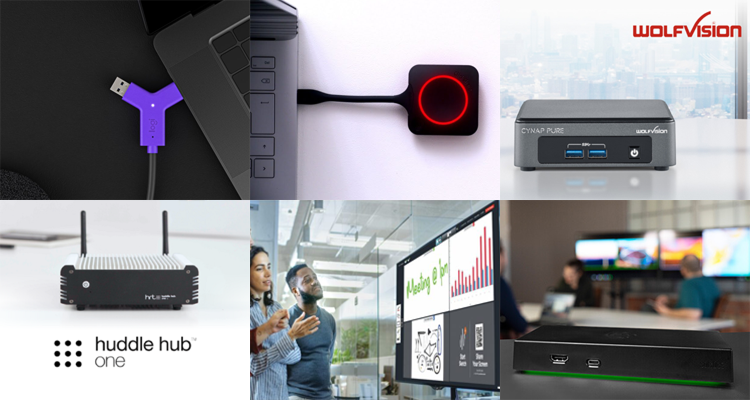 But remember, a key benefit of Barco’s unique wireless BYOM (versus just BYOM) is in the name: It’s wireless. Enabling BYOM in UCC rooms is great, but why would you choose a solution that’s wired? That’s like going back in time, and no one wants cords. No one wants clutter. Wireless BYOM — enabled through Barco’s ClickShare button — is simpler; it’s a better workflow. So there’s no extra network load or configuration.
But remember, a key benefit of Barco’s unique wireless BYOM (versus just BYOM) is in the name: It’s wireless. Enabling BYOM in UCC rooms is great, but why would you choose a solution that’s wired? That’s like going back in time, and no one wants cords. No one wants clutter. Wireless BYOM — enabled through Barco’s ClickShare button — is simpler; it’s a better workflow. So there’s no extra network load or configuration.
Why is BYOM becoming so widespread? Because it’s evolutionary. You could also say it’s quite futuristic. Think about it: BYOM is really sort of an open protocol system, much like how Google allows anyone to build a phone on its Android OS platform. We can start to think of BYOM this way too; we can also refer to BYOM, then, as “Open Rooms.”
The Open-Rooms Revolution
The Open Rooms concept, via BYOM, means that you can plug any USB peripherals — mic, camera or speaker set — directly into ClickShare Conference unit, instead of into the dedicated PC (personal computer) that’s required in an RBS.
Speaking of the PC in the room … since it’s only required in an RBS, going Open Rooms means the PC is no longer needed; no firmware updates, no software updates and no IT maintenance to maintain it. In an Open Rooms environment, using BYOM, you not only gain cross-platform compatibility to all UCC platforms; you also get it without the need for a dedicated PC. (Ironically, this may be one of the first times in tech history when removing a piece of technology from a system actually simplified it.)
This all happens regardless of the peripheral brand, as ClickShare Conference doesn’t play favorites — it enables video in all meeting rooms. And it just works. Through ClickShare Conference and BYOM, your own device now becomes the central nervous system for the meeting, automatically connecting to and activating those meeting peripherals for use. As a user, you’ll just see each of these (camera, mic and speaker) as an extension of your own system. That means ClickShare Conference tailors to the user’s process, the user’s device, and the user’s UCC preferences.
After a successful meeting, it’s onto the next one in another ClickShare Conference room. With Open Rooms, all rooms are open to all users!

Source: Barco News & Blog: “ClickShare Conference gets top approval ratings from global businesses”
Open Standards vs. Proprietary Solutions
If all this weren’t enough, moving the AV industry toward an Open-Source Rooms concept means removing the need for proprietary software and services, too. In addition to giving users more flexibility and choice (no vendor lock-in), this shifts the power dynamic back into the hands of the AV integrator — rather than where it is now with the UCC platform provider. You see, if you build and outfit a room dedicated to one videoconferencing platform, guess who controls the room? Not the user. Not the integrator. The UCC platform provider. Don’t believe me? Go ask your IT department to show you how they manage their dedicated RBS. Note that they log into that manufacturer’s site to troubleshoot. So, who do you think actually controls administrating that room? You guessed it.
Financially, moving to Open Rooms and BYOM can pay for itself in just a few months:
- No need for expensive meeting room software licenses
- No requirement for proprietary hardware and software to integrate a specific conferencing solution
- With setup times reduced from seven minutes to seven seconds, users save valuable time, time that was originally wasted on setting up meeting-room equipment
Importantly, an Open Rooms approach to design means the AV or IT integrator — not the UCC provider — owns the relationship with the client.
Looking Forward — “One-Click Join” via the ClickShare App
ClickShare Conference continues to evolve as we tell this story today. In late 2020, Barco will launch an exciting new ClickShare application that will integrate all UCC platform calendars into one — so your Teams calendar will live alongside your Webex calendar right next to your Zoom calendar. The ClickShare app will allow users to live inside one universe, ClickShare, rather than on multiple ones. So no more toggling from platform app to platform app to locate and launch each separate meeting.

The heart of all this? The ClickShare button — what we mentioned earlier enables the “wireless” part of wireless BYOM. Plugging in the ClickShare button activates ClickShare Conference to instantly recognize all meeting-room peripherals as users connect to their meetings. And there are some more exciting developments in the works for early 2021 (though for now, our lips are sealed). But don’t worry, the button isn’t going anywhere.
With a new ClickShare application, and all meeting calendars integrated into one, Barco now makes the process even simpler. With the ClickShare application, it’s one-click join.


Unpacking HaaS (Hardware-as-a-Service): Good, Bad or Ugly?
There’s one final topic we need to discuss, and it’s called HaaS (or Hardware-as-a-Service). While you may already be familiar with the term, there’s been a lot of new, recent buzz on HaaS. During COVID-19, seeing the need to provide their clients with a packaged-pricing approach, UCC platform manufacturers created (or amped up) their exclusive HaaS bundles to try to keep momentum strong for room-based systems — despite a massive decline in in-office use this year.
These packaged hardware bundles include all the room hardware you’d need in an RBM. They’re incentives to get the integrator to stick with, or buy, RBMs despite a huge decrease in meeting-room usage during the pandemic. At first glance, HaaS offerings seem awesome: Instead of buying all the USB gear, the room controller or even the display, you get it all in one packaged, pre-integrated price. It’s usually billed monthly — like a lease.
So is HaaS, Hardware-as-a-Service, good or bad for the AV integrator? Well, HaaS only applies to purpose-built rooms, not Open Rooms. Additionally, for the AV integrator searching for long-term client relationships, there are downsides. Here are five clear reasons why HaaS doesn’t work:
- By buying into HaaS, you’re tying all your clients to one UCC platform and an inflexible RBM, rather than a flexible Open Rooms concept.
- UCC platform providers already own the client-provider relationship when customer service is needed. (Did you catch our earlier example of what to do when you need to make changes to the room?). With RBMs, UCC providers only further solidify that they are the ones who will control (and bill) for the AV gear, too.
- With a dedicated-room approach to UCC, you could be putting all your eggs in one UCC basket. Today, Zoom is dominating. But what about Google and its launch of Google Meet? And then there’s Cisco, BlueJeans (now owned by Verizon), Facebook and, of course, Microsoft.
- If you like the Open Rooms via BYOM approach, the HaaS concept just becomes about pricing — not platforms. It flips it to being about, simply, financial packaging.
- HaaS forces users to work one way, and it convinces all clients of the UCC platform to work their one way, too. WIth BYOM, you get to work however you want and, more importantly, however your client wants. If your 11 a.m. client is on Google Meet and your noon client is on Teams, you can accommodate both without any technical learning curve, connectivity issues, timing delays or planning issues for room compatibility.
An Open Rooms approach means not only integrating anyone’s USB hardware devices but also deciding when to upgrade them and how to future-proof them. You can even create simple “good, better, best” packaging of Open Rooms — this offers your clients more choices and could encourage a higher level of adoption as it removes the “Rooms” fees and allows for future-proofing based on budget rather than on availability of certified hardware.
Platform-Specific Conference Rooms Don’t Make Sense — But Open Rooms Do
The Open Rooms approach to meeting rooms provides choice while maintaining simplicity. It’s rapidly becoming the preference of users, while reiterating that the AV integrator is the one who owns (and should continue to own) the meeting-room relationship from client to vendor. With Open Rooms, you maintain room simplification with one-touch connectivity, UCC platform compatibility, and assurance of performance — but users (at home AND remote) gain choice. That’s two-fold:
- In-room participants benefit: For users in the room, ClickShare Conference makes every meeting room open for easy videoconferencing, with one-touch join. All users have to do is bring their own laptop (i.e., bring their own meeting). Imagine: Instead of joining a meeting on your own small laptop, sitting at your own desk with headphones on, you can now meet in the conference room equipped with all that costly professional AV equipment you paid for. No matter the room, no matter the camera, no matter the type of microphone or speaker.
- And remote workers do too: ClickShare Conference enhances the experience for remote participants too — as they can see and experience the same content that users in the room do. It’s all synchronized; with ClickShare Conference, meetings connect automatically (in all meeting rooms) throughout the enterprise. Collaboration is amplified. ClickShare Conference removes friction for all users — not just meeting-room users but at-home users too.
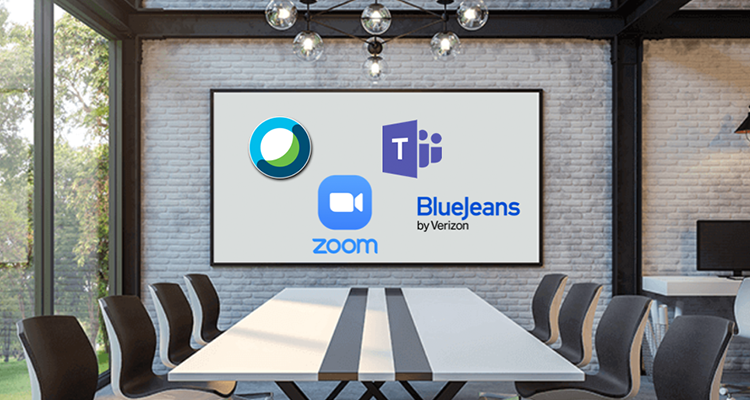 What’s more, COVID-19, the thing that likely slowed down the BYOM revolution in 2020, may very well accelerate it in 2021. As we do eventually go back to work, back to our offices and back to in-person meetings connecting to meeting participants remotely, wireless BYOM and the Open Rooms approach will allow for seamless, socially distanced meetings — whether they happen in a meeting room, a huddle space or in our cubicles. Or via all of those at one time! Culturally, meetings in collaboration rooms will continue to go on as they always have, mostly in the same way process-wise. But with Open Rooms, the technology will be simplified — the meeting workflow will be simplified — and there will be no learning curve. And since Open Rooms mean that rooms can be used for anything, AV and IT pros can now specify and buy any USB hardware and not have to feel limited to meeting gear that’s certified by each UCC platform individually. ClickShare Conference plays nice with them all.
What’s more, COVID-19, the thing that likely slowed down the BYOM revolution in 2020, may very well accelerate it in 2021. As we do eventually go back to work, back to our offices and back to in-person meetings connecting to meeting participants remotely, wireless BYOM and the Open Rooms approach will allow for seamless, socially distanced meetings — whether they happen in a meeting room, a huddle space or in our cubicles. Or via all of those at one time! Culturally, meetings in collaboration rooms will continue to go on as they always have, mostly in the same way process-wise. But with Open Rooms, the technology will be simplified — the meeting workflow will be simplified — and there will be no learning curve. And since Open Rooms mean that rooms can be used for anything, AV and IT pros can now specify and buy any USB hardware and not have to feel limited to meeting gear that’s certified by each UCC platform individually. ClickShare Conference plays nice with them all.
The straightforward, no-BS argument for Open Rooms: With so many people working from home — people who will continue working from home long after COVID-19 has subsided — end-user choice and preference becomes paramount. With a seemingly endless plethora of favored UCC platforms, Open Rooms and wireless BYOM will be critical approaches in our new hybrid working world. Barco ClickShare Conference allows teams to flip all their rooms into an employee-centric solution — enabling end users to work how they want, even being able to switch UCC platforms on the fly, meeting to meeting.
The future of UCC spaces is that collaboration rooms must accommodate all meeting platforms: not just Teams, not just Zoom, not just Webex. It’s up to us in AV, as an industry, to lead this movement toward Open Rooms — the most universal of all UCC solutions. Now is the best time to engage with clients to help them understand the benefit of this open approach for the short and long term. With a flood of information out there, AV integrators and IT managers have to inform their clients of all the options: ClickShare Conference is the most universal UCC solution for successful collaboration in meeting rooms. And integrators who make the best long-term decision for their clients, as opposed to just doing what seems easiest right now, will win.
To learn more about the Open Rooms Revolution, view the slide deck from the webinar delivered on Oct. 7, 2020 with Barco below.




